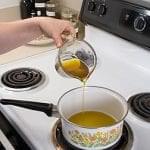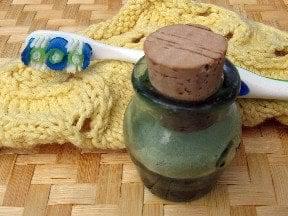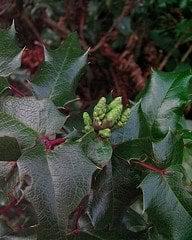An infused oil is an oil that’s been infused with the properties of one or more herbs. Infused oils, often called herbal oils or botanical oils, make great massage oils and are often used as the basis for healing salves. Some infused oils can be used for cooking, too.
There are two basic ways to create an infused oil, the cold method or the hot method. The cold method, which is actually done at room temperature, takes time but is relatively easy and requires little attention while the oil is soaking in the herb’s qualities. The hot method requires a direct heat source and close attention, but an infused oil can be prepared with this method relatively quickly.
Infused oils can be made from fresh or dried herbs. Some herbs, like St. John’s Wort, produce a better oil when infused from fresh plant material, while others seem to do well whether they are dried or fresh. Some herbs, such as Calendula, infuse better when you prepare them for infusion using a more complex extraction method and then infusing the oil with their properties using the hot method of infusion. Others, especially certain barks and roots, are better infused using heat because they don’t surrender their properties easily. Fresh, fragile plants can rot during the longer processing period required for cold infusion, too. It is a good idea to do a little research on the herb you’re planning to infuse so you can choose the most effective method, but in lieu of that you can choose the method that seems best to you and make a small quantity at first to check the quality. As with so many other herbal preparations, if it works well for you and yours, then you’ve chosen a good method.
Any oil can be infused with an herb. When you’re choosing the oil you want to use, keep your intended use for the finished oil in mind. I recommend using organic oils whenever possible, but as long as the oil you have chosen is expelled-pressed or cold-pressed, it should be relatively free of harmful chemicals. If you use the hot infusion method, you will be heating the oil gently, so butters and hard oils like Shea butter and Coconut oil can be used effectively.
I recommend using a stove top for your heat source for this procedure mainly because most beginning herbalists will have access to a pot and a stove and a stove’s heat is generally reliable. It’s very important your infusion comes to a temperature of about 100 degrees F. (38 degrees C.) or just a hair above body temperature and slightly warm when you sprinkle a drop on the inside of your wrist, but doesn’t go much higher than that. A crock pot set on low and monitored, a yogurt-maker, a hot-water bottle, or even an electric blanket are other possible heat sources for the low heat that will help the herbal properties transfer into the oil without frying the herbs. Whatever heat source you choose, monitor it carefully the first time around. If it works well, you can adjust this procedure to suit your needs.
A General Procedure for Making a Heat-Infused Herbal Oil
This is a basic procedure, not a recipe. I haven’t included specific measurements but have instead described the process and what to look for as you’re working. For specific recipes using this technique, see The Practical Herbalist Recipes.
Equipment you’ll need to make a heat-infused herbal oil:
- A cutting board and sharp knife (if you’re using fresh herbs)
- A rubber scraper, preferably one made of a material that can be thoroughly cleaned and doesn’t hold any odors, such as a heat-proof plastic one
- A spoon, preferably one made of a material that can be thoroughly cleaned and doesn’t hold any odors, such as a metal or heat-proof plastic one
- A pot and a heat source, such as a stove
- A label for your jar
After the oil has infused, you’ll need:
- A straining bag or several layers of cheese cloth and a strainer
- A bottle for the finished oil
- A label for your bottle
Ingredients for making a heat-infused herbal oil:
- A quantity of herbs or plant material, fresh or dried
- A quantity of good-quality oil
Procedure for making a heat-infused herbal oil:
Prepare your herbs. If you’re using fresh herbs, clean or shake any dirt from them. Unless they’re really, really dirty you don’t need to wash them with water. Chop them as finely as you can. If you’re using dried herbs, crush them so they’re mainly in smaller pieces, although you don’t necessarily want to powder them as that will make straining the fine particles out later more difficult. If you’re using an herb that infuses best after it’s been extracted into a liquid (such as into a strong water infusion or into a base alcohol), you should follow whatever steps are appropriate for extracting the herb.
Place your pot on the stove and add the oil to the pot.
- Using your spoon, stir in the herbs and gently heat the mixture. Ideally, you want to aim for a temperature of around 100 degrees F. (38 degrees C.). The point here is to warm the herb and oil but not to cook it.
- Continue to stir and watch the oil closely for a long time. I’ve generally given them two to four hours or more. I often become impatient, so two to four is about all I manage. But, if you can let it keep infusing safely all day, by all means do so. The longer you give it, the better the oil can soak in all those wonderful herbal properties.
- When the oil is infused, you should notice it has taken on some of the color and odor of the herbs. When you’re satisfied it’s ready, remove the mixture from the heat and let it cool. If your oils are ones that harden at room temperature, don’t let it cool so it’s no longer pourable.
- Strain the oil from the plant material. Carefully pour the mixture through several layers of cheesecloth and a strainer or through a fine mesh bag into a bowl. If you can, let the strainer sit and drip for awhile before proceeding.
- Once it’s strained, let the oil sit in the bowl for a few minutes so any sediment settles to the bottom of the bowl. If you’re using an oil that hardens at room temperature, you may need to return the oil to a clean pot and gently heat it so it doesn’t harden while the sediment settles out.
- Once the sediment has all settled, carefully pour the clear oil into your bottle. Remove as much sediment as you can because the sediment may cause your oil to go bad in time. If the oil is still cloudy, let it sit overnight then repeat this step.
- Label your jar and store it in a cool, dark place. Be sure to include the date, the kind of herb you infused, and uses so others will also know how to use it. At this point, you can use your oil to create a salve using The Practical Herbalist General Procedure for making a salve.








